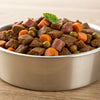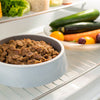How Much Wet Dog Food Should a Dog Eat? A Comprehensive Guide for Pet Owners
- Houndsy
Table of Contents
- Introduction
- The Importance of Proper Feeding for Dogs
- Understanding Feeding Guidelines for Canned Dog Food
- Calculating the Right Amount of Canned Food Based on Your Dog's Weight
- Considerations for Mixing Canned and Dry Food
- Adjusting Feeding Based on Life Stages and Health Needs
- Conclusion
Introduction
Did you know that nearly 59% of dogs in the United States are classified as obese or overweight? This eye-opening statistic highlights the critical importance of understanding our dogs' dietary needs and feeding them appropriately. As loving pet owners, we want to ensure that our furry companions receive the right balance of nutrition without overdoing it—especially when it comes to wet dog food.
In this comprehensive post, we will dive into the details of how much wet dog food a dog should consume daily. We will explore the various factors that influence portion sizes—including your dog's weight, age, and activity levels. By the end of our discussion, we will empower you to make informed, convenient decisions about feeding your dog, enhancing their health and happiness.
We will pave the way by discussing:
- The importance of proper feeding for dogs
- General feeding guidelines for canned dog food
- How to calculate the right amount of canned food based on your dog's weight
- Important considerations for mixing wet and dry food
- Ways to adjust feeding according to life stages and specific health needs
So grab your favorite beverage and get comfortable as we explore everything you need to know about how much wet dog food should a dog eat!
The Importance of Proper Feeding for Dogs
Feeding your dog the appropriate amount of food goes far beyond simply satiating their hunger; it is a fundamental requirement for ensuring their overall health and well-being. Overfeeding can lead to obesity, which is associated with serious health issues including heart disease, diabetes, and joint problems. Conversely, underfeeding may result in nutritional deficiencies and energy loss that can affect your dog's spirit and vitality.
Pet owners often find that the feeding guidelines provided on dog food packaging can be confusing. This is especially true when dealing with canned wet dog food—each brand has distinct recommendations based on various factors. That's where Houndsy comes in; our mission is to transform the feeding ritual into a streamlined experience that promotes well-being and convenience for both pets and their owners.
With our flagship product, the Houndsy Kibble Dispenser, you're able to manage portions effortlessly while ensuring your dog enjoys their meals to the fullest. This device showcases mid-century modern design and is built to simplify feeding, allowing you to set routines that favor consistency and effectiveness.
Understanding Feeding Guidelines for Canned Dog Food
When it comes to wet dog food, the feeding guidelines are typically expressed based on your dog's weight. These guidelines can vary widely between brands and formulations, as each recipe has its own caloric density. Understanding these guidelines is the first step in determining how much wet dog food your dog should consume daily.
General Feeding Recommendations
Here’s a general breakdown of how much wet dog food to feed based on your dog's weight:
- Under 10 pounds: 1/4 to 1/2 can per day
- 10 to 20 pounds: 1/2 to 1 can per day
- 20 to 40 pounds: 1 to 1.5 cans per day
- 40 to 60 pounds: 1.5 to 2 cans per day
- 60 to 80 pounds: 2 to 2.5 cans per day
- 80 to 100 pounds: 2.5 to 3 cans per day
These figures serve as general guidelines, recognizing that dogs may require adjustments based on their specific activity levels, age, and health conditions.
Key Factors to Consider
-
Caloric Density: Different canned foods offer varying levels of calories. It pays to examine the nutrition label to identify how many calories are present per serving and align those figures with your dog's daily needs.
-
Activity Level: More active dogs typically require more food, as they burn more calories during the day. Conversely, dogs that are more sedentary may need less.
-
Health Conditions: Dogs facing specific health challenges—such as weight management issues or age-related concerns—may have distinct dietary requirements that deviate from what the charts present.
-
Life Stages: Puppies, adult dogs, and senior dogs each have different nutritional needs that should be considered when determining serving sizes.
Calculating the Right Amount of Canned Food Based on Your Dog's Weight
To accurately calculate the appropriate amount of wet dog food for your pup, follow these steps based on their ideal body weight rather than their current weight—especially if they are overweight.
Step-by-Step Guide to Feeding Calculations
-
Determine Ideal Weight: Consult with your veterinarian to establish your dog’s healthy weight based on breed, age, and health status.
-
Feeding Guidelines: Reference the feeding guidelines on the wet food label. The recommended amount will usually indicate how many cans per weight.
-
Daily Portions: For example, if you have a dog weighing 30 pounds and the feeding guideline is 1 can for every 15 pounds, you would feed them 2 cans per day (30/15 = 2).
-
Divide into Meals: If you decide to feed your dog twice a day, you can simply split the total number of cans. For a daily ration of 2 cans, this means serving 1 can per meal.
-
Monitoring and Adjusting: Keep a close eye on your dog’s weight and overall condition. If you notice unexpected weight gain or loss, adjusting food intake in consultation with your vet is recommended.
Example Calculation
Let’s consider a 50-pound dog:
- Daily Total: According to general feeding guidelines, they should receive about 1.5 to 2 cans of food per day.
- Using the Midpoint: Choosing the midpoint of 1.75 cans allows us to divide the portion into two meals.
- Per Meal: Each meal would consist of approximately 0.875 cans (or about 7/8 can).
This process fosters a consistent feeding routine, ensuring your dog receives optimal nutrition.
Considerations for Mixing Canned and Dry Food
Mixing wet and dry dog food can offer various advantages, including enhanced taste, varied textural experiences, and the nutritional benefits of both food types. However, this approach requires thoughtful consideration to avoid overfeeding and ensure balanced nutrition.
How to Mix Canned and Dry Food
When deciding to mix canned and dry food, consider these helpful guidelines:
-
Adjust Portions: A general rule is to reduce the dry food portion by about 1/3 cup for every half can of wet food added. For example, if you add half a can of wet food, take out 1/3 cup of dry food.
-
Monitor Daily Caloric Intake: Maintaining an awareness of total calories consumed is vital. If the combined caloric count exceeds what is ideal for your dog, adjustments may be needed.
-
Experiment with Ratios: Your dog may have preferences; experimenting with different wet-to-dry ratios may help you identify the right mixture that your pup enjoys.
Benefits of Mixing
- Increased Palatability: For picky eaters, mixing helps enhance the flavor and enjoyment of their meals.
- Enhanced Hydration: The moisture content in wet food promotes hydration, which is especially beneficial in dogs that may not drink enough water.
- Nutritional Variety: Combining different types allows for a broader spread of nutrients, thus contributing to better overall health.
Adjusting Feeding Based on Life Stages and Health Needs
As dogs age, their nutritional requirements evolve. Whether they are puppies in active growth or seniors requiring more specialized diets, their feeding regiment should adapt accordingly.
Puppies
Puppies require more energy-packed diets to support their rapid growth. During this stage, they typically need two to four times the amount of food per day than adult dogs with similar body weight. Consult your veterinarian for tailored guidance based on your puppy's breed and growth stage.
Adult Dogs
For adult dogs, maintaining balanced feeding routines is crucial. Active dogs may require larger portion sizes than their sedentary counterparts. Regular adjustments based on their body condition score will ensure they remain healthy and fit.
Senior Dogs
Senior dogs often experience a decline in energy levels, leading to lower calorie recommendations. Look for senior dog formulations that typically offer lower calorie counts, often combined with nutrients such as glucosamine for joint support. Monitoring their weight carefully is essential for adjusting portion sizes.
Conclusion
Understanding how much wet dog food your dog should eat daily is vital for fostering their long-term health and wellbeing. The guidelines illustrated in this post can empower you to provide an appropriate diet tailored to your dog's unique needs, factoring in aspects such as their weight, age, activity level, and overall health.
At Houndsy, we believe that feeding time should be a joyful experience, free from stress or confusion. Our Houndsy Kibble Dispenser is designed to ensure that perfect portion control is effortless, enabling you to focus on creating memorable moments during mealtime. Elevate your dog feeding experience today by checking out our dispenser!
FAQ
-
How do I determine the right amount of canned food to give my dog?
- Start by examining the feeding guidelines on the canned food packaging based on your dog's weight. Make adjustments for activity levels and consult your veterinarian for personalized advice.
-
Can wet food be mixed with dry food?
- Yes! Mixing wet food with dry can enhance flavor and hydration. Just remember to balance the portions to prevent overfeeding.
-
How many meals should I feed my dog each day?
- Most adult dogs thrive on two meals per day, while puppies may require three to five meals. Senior dogs typically do well with two meals but should be evaluated by a vet for specific needs.
-
What if my dog is overweight?
- Consult your veterinarian for a weight management plan including appropriate feeding amounts and exercise opportunities tailored to your dog's specific needs.
-
Are there special dietary needs for senior dogs?
- Senior dogs may benefit from lower-calorie foods and those enriched with joint-supporting ingredients. Always team up with your veterinarian for tailored dietary recommendations.












